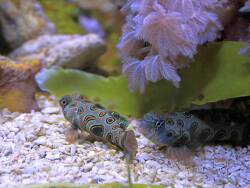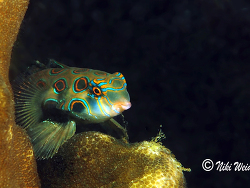Info
Synchiropus picturatus, Peters, 1877
The lyrefish family (Callionymidae) is a group of perch relatives (Percomorphaceae). Many lyrefish are very colorful and are therefore popular to keep in aquariums. However, lyrefishes are not so easy to keep because of their food requirements, as they have to eat constantly . Synchiropus picturatus can therefore be kept mainly in well acclimated tanks with several months standing time and correspondingly distinctive microfauna, because it feeds on micro animals, which are found in the substrate and on the stones.
Sometimes a change to frozen food works, sometimes not. It has to be said that the Synchiropus picturatus accepts food in the aquarium a bit earlier than the also very popular Synchiropus splendidus.
The tank should also offer good hiding places. Under no circumstances should two males be placed in the same tank, as they would fight each other to the death. The males can be recognized by the extended dorsal fin spine.
Keeping them in pairs is no problem and even advisable if the tank is big enough. There is nothing more beautiful than the spawning behavior of lyrefish.
One should not socialize Synchiropus splendidus and Synchiropus picturatus - this usually goes wrong!
The LSD fish - Synchiropus splendidus asserts itself, in our experience, and will not leave the other "Blue" Mandarin fish - Synchiropus picturatus alone!
Feeding intake.
The fish take a long time to eat at the beginning, before the food is taken up, a close inspection is carried out. After acclimatisation, the offered frozen food is eaten without problems. It should be noted that wild-caught fish behave differently than offspring when it comes to food intake. In the case of offspring, the size of the fish purchased also plays a role in the choice of food.
Pool requirement.
The tank volume specified above is less relevant. What is important is that there is enough or suitable food in the tank, because they have to eat constantly and survive without supplementary feeding in well-worn tanks with several months of standing time and correspondingly well-developed microfauna. During this time, they feed on micro-animals found in the substrate and on the stones. There must be enough bottom surface for successful maintenance.
Furthermore, food competitors are also important (e.g. pipefish, small wrasses, etc. or by keeping them in pairs), which chase the limited live food on the substrate. It is also advantageous to keep a small copepod farm (several boxes) in the beginning. After switching to frozen food, live food breeding can be discontinued.
Live benethic (bottom-living) copepods - Tigriopus californicus or Tisbe biminiensis - can always be added if available.
Unfortunately, there is no guarantee that the switch from live food to frozen food will be successful. In this case, extensive live food breeding is necessary for our fish to survive in the aquarium.
The LSD fish - Synchiropus splendidus asserts itself, in our experience, and will not leave the other "Blue" Mandarin fish - Synchiropus picturatus alone!
Synonyms:
Callionymus picturatus Peters, 1877
Pterosynchiropus picturatus (Peters, 1877)
The lyrefish family (Callionymidae) is a group of perch relatives (Percomorphaceae). Many lyrefish are very colorful and are therefore popular to keep in aquariums. However, lyrefishes are not so easy to keep because of their food requirements, as they have to eat constantly . Synchiropus picturatus can therefore be kept mainly in well acclimated tanks with several months standing time and correspondingly distinctive microfauna, because it feeds on micro animals, which are found in the substrate and on the stones.
Sometimes a change to frozen food works, sometimes not. It has to be said that the Synchiropus picturatus accepts food in the aquarium a bit earlier than the also very popular Synchiropus splendidus.
The tank should also offer good hiding places. Under no circumstances should two males be placed in the same tank, as they would fight each other to the death. The males can be recognized by the extended dorsal fin spine.
Keeping them in pairs is no problem and even advisable if the tank is big enough. There is nothing more beautiful than the spawning behavior of lyrefish.
One should not socialize Synchiropus splendidus and Synchiropus picturatus - this usually goes wrong!
The LSD fish - Synchiropus splendidus asserts itself, in our experience, and will not leave the other "Blue" Mandarin fish - Synchiropus picturatus alone!
Feeding intake.
The fish take a long time to eat at the beginning, before the food is taken up, a close inspection is carried out. After acclimatisation, the offered frozen food is eaten without problems. It should be noted that wild-caught fish behave differently than offspring when it comes to food intake. In the case of offspring, the size of the fish purchased also plays a role in the choice of food.
Pool requirement.
The tank volume specified above is less relevant. What is important is that there is enough or suitable food in the tank, because they have to eat constantly and survive without supplementary feeding in well-worn tanks with several months of standing time and correspondingly well-developed microfauna. During this time, they feed on micro-animals found in the substrate and on the stones. There must be enough bottom surface for successful maintenance.
Furthermore, food competitors are also important (e.g. pipefish, small wrasses, etc. or by keeping them in pairs), which chase the limited live food on the substrate. It is also advantageous to keep a small copepod farm (several boxes) in the beginning. After switching to frozen food, live food breeding can be discontinued.
Live benethic (bottom-living) copepods - Tigriopus californicus or Tisbe biminiensis - can always be added if available.
Unfortunately, there is no guarantee that the switch from live food to frozen food will be successful. In this case, extensive live food breeding is necessary for our fish to survive in the aquarium.
The LSD fish - Synchiropus splendidus asserts itself, in our experience, and will not leave the other "Blue" Mandarin fish - Synchiropus picturatus alone!
Synonyms:
Callionymus picturatus Peters, 1877
Pterosynchiropus picturatus (Peters, 1877)







 NikiWei
NikiWei



































